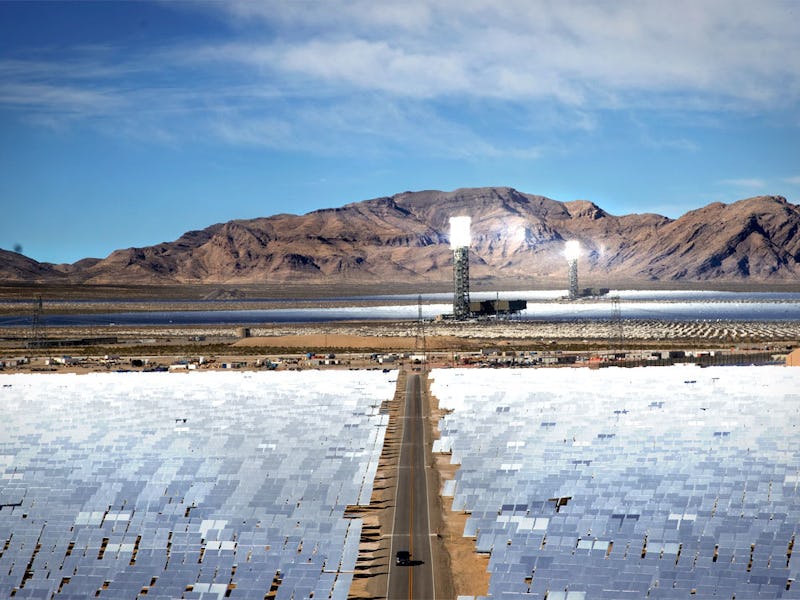Solar energy: the 8 ideas that will make panels more efficient and cheaper
It's not all about flat silicon panels.

Think solar energy is just about rows of flat silicon panels, sitting in a field collecting energy? Think again.
A new report from the International Renewable Energy Agency released this week explains how the sun looks set to shine on solar energy systems over the coming decades, with a wealth of advancements and dropping prices that could boost adoption.
The paper makes for optimistic reading. Solar deployment alone could lead to a 21 percent reduction in total carbon dioxide emissions by 2050. The energy source could account for 25 percent of the world’s electricity needs by that point, second only to wind power, with 8,519 gigawatts of total installed capacity. This, combined with other efficiencies in buildings and transport, could lead to a 70 percent reduction in emissions from 2020 levels. That’s assuming society takes on a radical decarbonization plan, attuned to meeting targets outlined in the Paris Agreement and one that mixes clean energy with efficiency savings.
IRENA's assessment of energy emissions.
But it’s not just flat panels harvesting light that could lead the way. Here’s some of the other ideas outlined in the report that could play a role.
8. Solar trees
Solar trees would work similar to a real tree, in that “leaves” would collect light and use that as energy. The IRENA claims they use 100 times less space to produce the same amount of electricity.
Watch this video about a solar tree in India, which can collect five kilowatts of power in just four square feet of land:
7. Advanced solar materials
Beyond standard silicon, which commands around 95 percent of the market, researchers are exploring new materials. These could reduce prices and improve on silicon’s efficiency, which has achieved a maximum lab record of 26.7 percent.
- PERC cells, a relatively mature technology that adds a layer to the back of the cells to improve efficiency.
- Tandem cells. These stack on top of each other to convert different bands of light into energy. These hold the world record for solar cell efficiency, nearly doubling that of solar to reach 46 percent efficiency! Unfortunately, they are very expensive and hard to manufacture.
- Thin-film cells. These can be cheaper but offer lower efficiency. They command around five percent of the market.
- Perovskites. These are made from minerals, easier to produce at low temperatures, and offer comparable efficiency to silicon at 24.2 percent. Large-scale production is difficult at this stage.
These varying materials are at different stages of production.
The race to transform the solar panel.
6. Double-sided solar cells
These panels place cells on the reverse side as well. That captures reflected light from the other side, and could offer boosts between five and 20 percent more energy. They have been touted as a solution for sun-starved Scotland, where overcast skies make it an ideal use case. They command around five percent of the current market, but the International Technology Roadmap for Photovoltaic expects this to increase to 40 percent in the next 10 years.
5. Half-cells
This process would involve cutting a processed cell in half, which improves durability and can offer a boost of up to five watts. It has reached efficiencies up to 18 percent. This accounted for less than three percent of the market in 2017, but could reach 10 percent next year.
4. Solar roofs
Adding solar panels to a home’s roof first entered the public imagination in 1979, when Jimmy Carter installed panels on the White House. Decades later, whole roofs are being made out of solar panels. Perhaps the most visible example is the Tesla Solar Roof, introduced in November 2016, which received a smattering of early installations in the spring of 2018. The company unveiled a third-generation design in October 2019 and now expects to roll out to more states, pushing prices below the cost of a roof plus solar panels.
Tesla Solar Roof V3.
3. Floating solar
Floating solar panels comprised 1.1 gigawatts of installed capacity in 2018, but that looks set to improve. South Korea is expected to build the world’s largest floating solar installation next year at 102.5 megawatts. A dairy farm in Rotterdam has even combined it with a dairy farm, creating a zero-emission floating installation.
The floating farm in action.
2. Thermal systems
This would use the extra heat energy from solar panels, where a cooling agent is used to cool the panels and the newly-heated leftovers are used for other purposes. Researchers at SINTEF in Norway have produced a panel that uses water to cool the panels and creates a hot water byproduct. This allows users to capture the otherwise-wasted heat energy and also increase the efficiency of the panels.
1. Agrophotovoltaics
Placing solar panels above crops offers a more efficient use of land. Researchers at Oregon State University discovered that covering just one percent of the world’s farmland with solar would be enough to meet humanity’s energy needs. One airport in the Indian state of Kerala, which runs its entire operations from solar panels, also grew 60 tons of vegetables in 2018.
With so many big ideas on the way, it’s an exciting time for the industry at large.